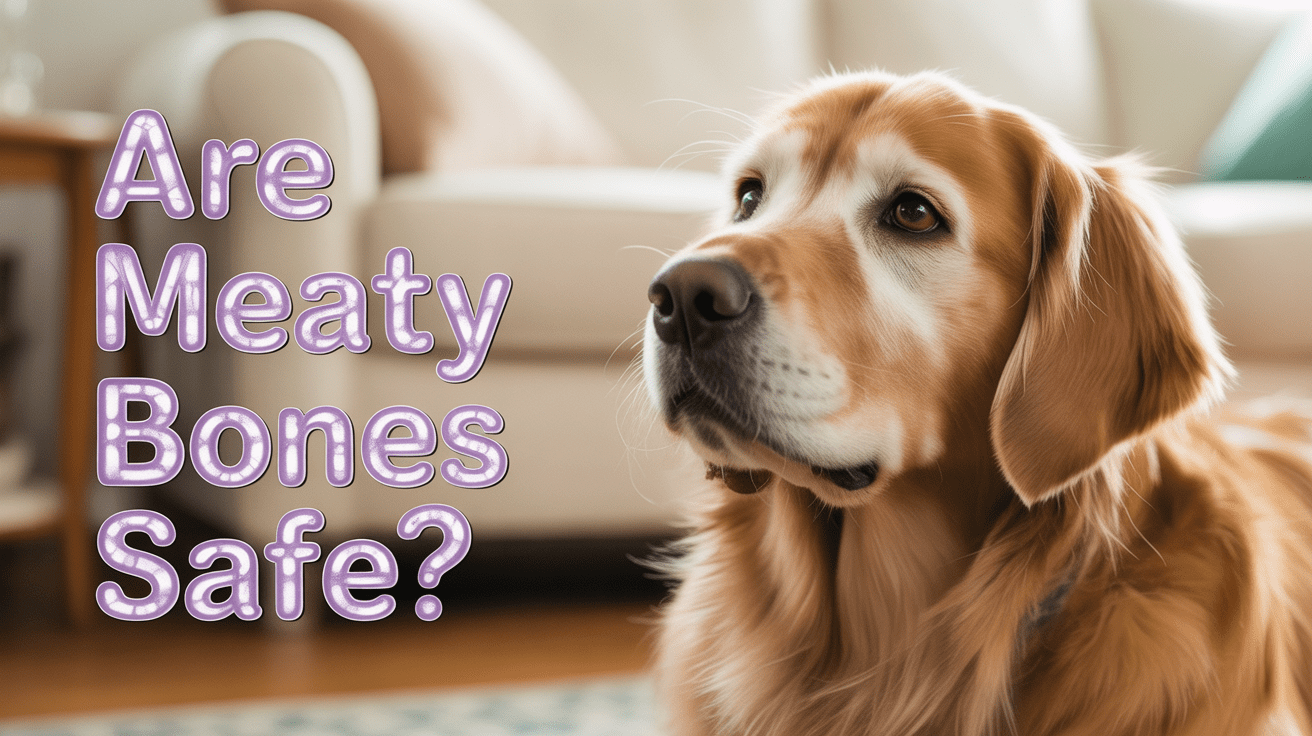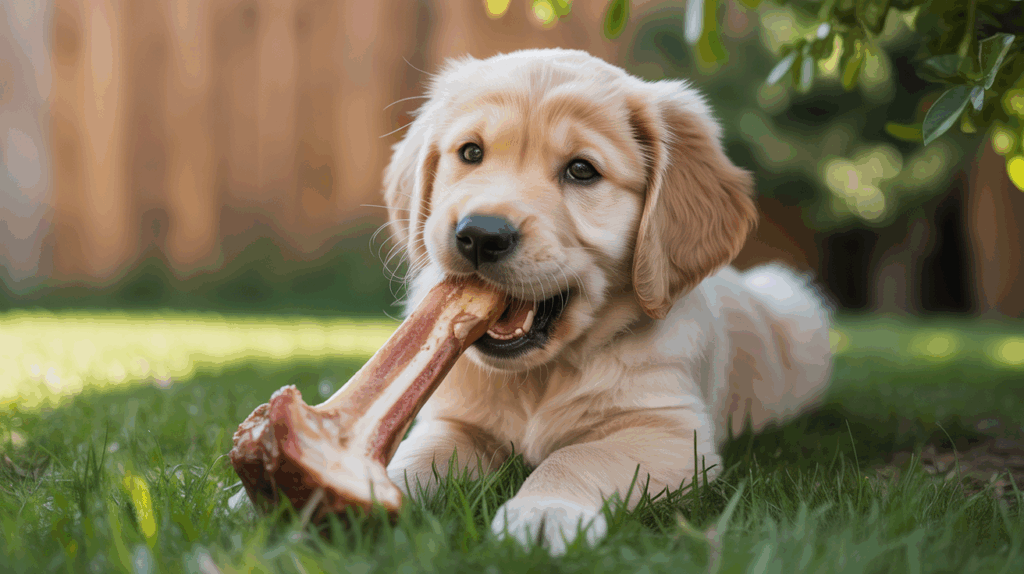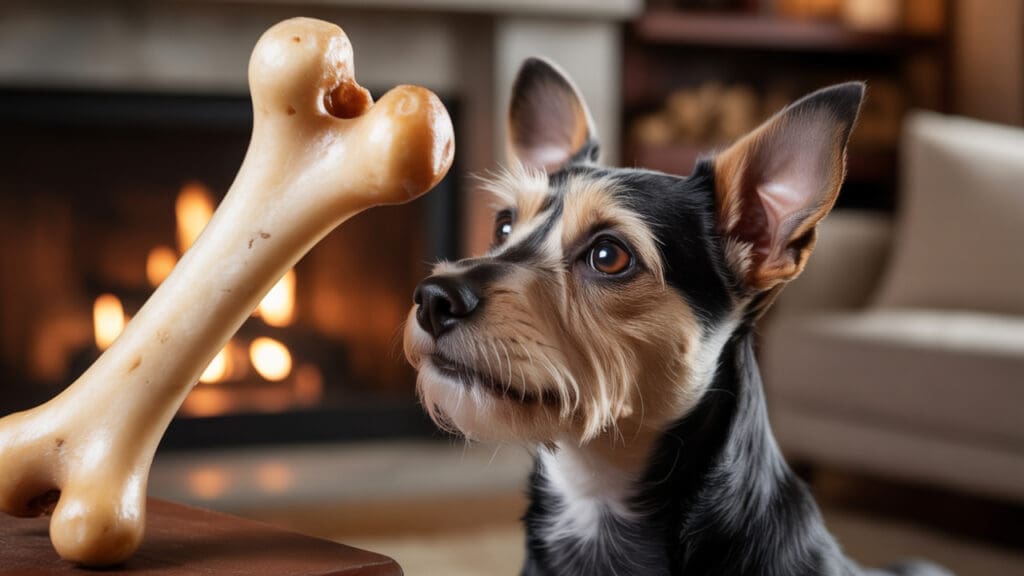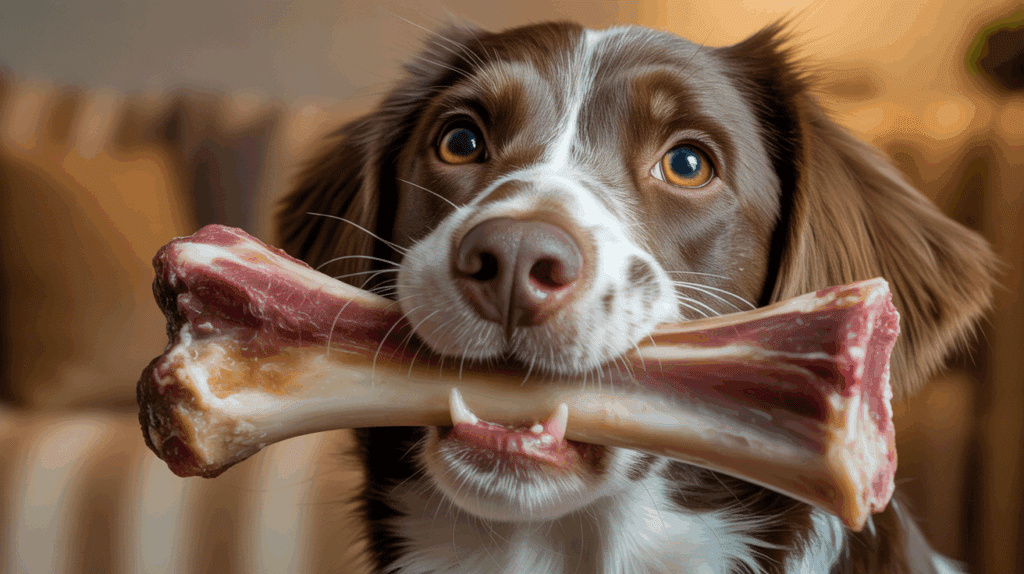
Newsletter Subscribe
Enter your email address below and subscribe to our newsletter

Enter your email address below and subscribe to our newsletter

You might think that your dog loves the leftover bone you’ve given them, seeing how eagerly they chew on it. However, that later gets you to pay an emergency visit to your vet the same night. This is quite a common story.
Dogs eat bones. That’s the logic most of us have grown up knowing. But now, you start questioning. Are meaty bones safe for dogs?
In short, know that some raw, non-weight-bearing bones can support your dog’s dental health. They even provide your canine friend minerals like calcium and phosphorus. If done right, feeding your dog bones could save you hundreds of dollars on professional cleanings in the long run.
The trick is to choose the right kind of bones to give your little pal. Many choices, cooked chicken bones or dense beef marrow bones, can splinter or fracture your dog’s teeth. This can lead to painful injuries. And you’ll likely need to fork out around $500 to $1,500 for treatment.
Veterinarians warn that we shouldn’t assume that bigger is better. Oversized bones are, in fact, often quite dangerous. Other risks that we might overlook include bacterial contamination and digestive blockages. All these factors make choosing the right bones more complicated than you’d think.
Now, let’s dive into the article and check out which bones are safe for your canine companion. You’ll know which to avoid and what alternatives you can give your furry friend. Your extra research will prove worthwhile in the form of your dog’s health and your peace of mind.

Yes, but only specific types and under strict supervision. Raw, non-weight-bearing bones (like chicken necks or lamb ribs) can provide dental and nutritional benefits. Cooked bones of any kind are never safe as they splinter easily and can cause life-threatening injuries. Always choose a bone appropriate for your dog’s size and chewing style, and always supervise them.
Safer Alternatives: For dogs who shouldn’t have bones, consider vet-approved dental chews, rubber toys (like Kongs), or dehydrated single-ingredient treats (like bully sticks).
In my practice, I see the consequences of cooked bones every week. The emergency surgery to remove splintered bone fragments can cost $3,000 to $7,000, and that’s not even including the potential complications that can be life-threatening. The safest rule is this: if you didn’t buy it specifically as a raw, non-weight-bearing bone from a trusted source for your dog, don’t give it to them. Cooked bones become brittle and splinter easily, turning what seems like a natural treat into a surgical emergency. – Vet expert

Perhaps you might have seen others feed their dogs leftover bones after dinner. And that’s the advice that’s stuck with you. But are meaty bones safe for dogs? Are meaty bones good for dogs, to begin with?
Meaty bones are exactly what they sound like. They are raw bones with muscle meat still attached, such as ribs, necks, or chicken frames. These bones provide your canine friend both chewing satisfaction and, more importantly, nutritional value.
The practice of feeding meaty bones to our dogs is rooted in the raw feeding movement and the idea that our canine companions can benefit from eating whole, natural foods. We just need to know which are safe to feed, and which are not.
Now, you might have heard people say that cooked bones are great for your dog. But, in fact, these bones splinter easily and can become dangerous to your furry pal. Vets also say that weight-bearing bones from large animals can fracture your dog’s teeth because of their hardness. Sample poultry bones, on the other hand, may pose choking risks.
You can definitely find high-quality bones from your butcher or even a specialty pet supplier. But keep in mind that securing high-quality bones is just part of the equation. You’ll need to store them properly, thaw, and portion them strategically to avoid bacterial contamination.
When done right, bone feeding can support your dog’s dental health and mimic natural feeding behaviors. In the long run, bones may also be cheaper than some dental chews. So, learn to choose the right bones for your dog. And never leave them unattended while chewing.

Now that you understand the significance of feeding bones to your canine companion, let’s take a look at the next important question. What meat bones are safe for dogs? After all, meaty bones can offer both nutritional and dental benefits.
Vets generally say that safe meat bones for dogs are those that are raw and non-weight-bearing. So, that means chicken necks, turkey wings, lamb ribs, or duck frames are the go-to. These bones are softer. They are less likely to splinter. And best of all, they are easier for your dog to chew through without fracturing their teeth.
By contrast, cooked bones, especially roasted or smoked ones, are brittle, and they are prone to shattering. Also, you might have heard people say that bigger bones are safer, with less choking risk. Unfortunately, oversized beef marrow bones can actually crack your dog’s teeth because of their density. You’ll need to choose those that match your dog’s size and chewing style.
Cost is something you’ll need to consider for long-term bone feeding. You can buy safe raw bones that are affordable from your butcher or specialty pet store. They are sometimes sold at a cheap price as by-products that we humans don’t eat.
If you want to opt for premium bones like grass-fed or organic sources, however, they will definitely cost more. That said, this can be a worthwhile investment long-term compared to the veterinary cleanings you’ll be paying for.
Now, the best practice is to supervise while they chew. Always discord any small fragments. And keep in mind that you shouldn’t leave bones out for long periods to prevent bacterial growth.
As a rule of thumb, vets recommend that we limit our dogs’ chewing sessions to 10–15 minutes. Afterwards, we should discard the leftovers. Don’t feed bones to your dog on a carpet or soft surfaces. The shards can be too small for you to notice.
It certainly feels natural and wholesome to feed your dog meaty bones. But know that there are some risks involved. And you should know how to choose meat bones safe for dogs before setting up your little one’s diet routine.
The biggest danger when it comes to bone feeding is splintering. All bones splinter, but cooked ones are especially prone to breaking into sharp shards. And when these shards are chewed or ingested by your dog, they can puncture their mouth, throat, or digestive tract. Raw bones, though safer, can cause choking or intestinal blockages if they are too small.
The next risk is dental fractures. If your dog chews on dense, weight-bearing bones like beef femurs, they have a high chance of cracking their molars. This is a painful experience for your canine companion, and an expensive one for you to fix. You’re looking at several hundred to over a thousand dollars.
Even if your dog doesn’t break their teeth, repeated gnawing on large bones can wear away their enamel. Also, large marrow bones (something that your dog probably loves) usually contain rich, fatty marrow inside. So, it can lead to diarrhea or vomiting if they eat too much.
Another risk is constipation or impaction. If your dog eats too much bone material (even safely prepared ones), you might start seeing some chalky white stools from them, or constipation might follow. In some cases, excessive bone fragments can pack tightly in the intestines, leading to impaction.
Furthermore, there’s the risk of bacterial growth if you leave the bones out for too long. Raw bones can carry bacteria, and these can spread quickly through saliva, surfaces, or handling. So, not only your dog might be at risk. You and your family might be exposed to bacteria like Salmonella and E. coli.
You should freeze softer raw bones before giving them to your dog. That way, the bones can offer a slightly firmer texture, and it makes them last longer without becoming brittle. But if your canine pal is an aggressive chewer, consider using safer alternatives or talk to your vet before introducing bones at all.
You might have found the answer to the question: Are raw meaty bones safe for dogs? But let’s take a closer look at the upside. Raw bones can provide many physical and behavioral benefits for your canine companion beyond just being a natural chew toy.
The first, and possibly the most recognized benefit, is dental health. Your dog’s chewing on raw meaty bones can help scrape away plaque and tartar. This lessens (not eliminates) the need for professional cleanings, which can cost $170 to $350 when performed by a general vet, or up to $4,000 for a specialist. So, it’s a cost-saving strategy, and possibly a safe one if done right.
Nutritionally, raw meaty bones provide essential minerals like calcium and phosphorus for your dog. This translates to stronger bones and joints. These bones also have small amounts of magnesium and potassium to help with muscle contraction. Other nutritional contents include collagen, glucosamine, chondroitin, healthy fats, protein, and limited micronutrients.
Your canine’s natural chewing behavior is also beneficial for their mental health, reducing their anxiety and destructive habits. Vets generally agree that raw meaty bones are a healthy outlet for dogs that have high energy levels or chewing needs.
Another behavioral benefit of your dog’s gnawing on a raw bone is the satisfaction of their instinctual drive to chew. This helps reduce boredom and promote calmness. You may even see that regular chewing sessions can help your canine companion settle more easily after exercise.
While raw meaty bones can offer benefits, the bacterial contamination risks are more serious than many pet owners realize. Recent studies reveal alarming statistics that every dog owner should understand.
Research from Brazil in 2020 found that dogs fed raw meat-based diets were almost 30 times more likely to shed Salmonella in their feces compared to dogs on conventional diets. In the Netherlands, a comprehensive study of 35 commercial frozen raw meat diets revealed extensive contamination: 80% contained extended-spectrum beta-lactamase-producing E. coli, 54% had Listeria monocytogenes, and 20% contained Salmonella species.
Healthy adult dogs typically handle these bacteria better due to their robust digestive systems. However, puppies, senior dogs, or immunocompromised animals face significantly higher risks of developing serious infections.
The risk extends beyond your dog. Dogs consuming raw bones can shed dangerous bacteria for weeks through their saliva and feces, creating contamination throughout your home. This poses particular dangers to:
If you choose to feed raw bones, implement these non-negotiable safety measures:
According to studies published in veterinary journals, raw diets pose infectious disease risks to both pets and humans, with bacterial shedding occurring even after single raw meals.
For generations, people have believed that bones are good for dogs. And they can be. It’s just that many of these assumptions about meat bones safe for dogs are oversimplified. Now, let’s take a look at some of these common pitfalls.
Most of us think that all bones are safe for our dogs. And this is possibly one of the biggest misconceptions out there. Know that cooked bones are among the most dangerous because they become brittle and splinter easily. Complications can range from choking and injuries to even emergency surgery. So, be careful.
The next myth has been repeated throughout this article. That is “bigger bones are automatically better.” Those large beef or marrow bones may be harder to break, but they can also fracture your dog’s teeth and cause long-term dental damage. Long-term gnawing is also not good for your dog’s enamel.
Some people also believe that chewing bones alone is enough to maintain their dog’s oral health. It’s true that raw meaty bones can reduce plaque buildup. However, they cannot replace regular vet checkups or professional cleanings. It does help, but relying solely on this method can leave your dog developing conditions like hidden gum disease.
Maybe your dog isn’t much of a bone chewer, or maybe they just can’t. Or perhaps you’re just worried about the risks and don’t know if you’re doing things right. If that’s the case, you can explore some safe alternatives to meat bones for dogs. The good ones can provide your dog with both satisfaction and health benefits.
The first one on the list is dental chews. These are specially designed products that mimic the scraping action of bones. And they help with reducing your dog’s plaque and tartar buildup. You might need to spend a few dollars per chew, but they are predictable in terms of safety.
That means less worrying about the risks of splintering or choking. Just make sure to get a vet-approved or VOHC (Veterinary Oral Health Council)–certified option, not a low-quality chew filled with artificial additives.
If your dog happens to be a heavy chewer, you might need a durable rubber or nylon toy, like Kongs and Nylabones. They can offer long-lasting engagement. Some toys may even allow you to stuff healthy treats into them or even freeze them. You can then turn them into DIY puzzles that can keep your canine friend entertained and mentally stimulated.
Another safe alternative is dehydrated animal parts. These include tendons, tracheas, and bully sticks. Your dog will still find satisfaction chewing these natural sources. And they are much easier to digest than whole bones.
Still, moderation is key, so don’t feed your furry friend too many of these treats. You don’t want to deal with an upset stomach, and they can add unnecessary calories.
Not every dog is suitable for bone feeding. Before introducing raw meaty bones to your dog’s diet, ensure you can answer “yes” to every item on this veterinary-approved checklist:
Health Prerequisites:
Dental Requirements:
Behavioral Assessment:
Supervision Commitment:
Professional Approval:
If you cannot confidently check every box, consider safer alternatives like VOHC-approved dental chews instead
Once you realize that bones may not necessarily be safe for your dog, questions naturally start to surface. Many of us have been there. And unfortunately, there’s no simple yes-or-no answer. To help clear some confusion, here are the most frequently asked questions that pet parents have.
Raw, non-weight-bearing bones can be safe when you match them to your dog’s size and chewing habits. But cooked bones are never safe because they splinter.
Cooked bones, small poultry bones, and dense weight-bearing bones like beef femurs are unsafe. They risk splintering, choking, or fracturing your dog’s teeth.
Veterinarians advise offering your dog raw bones only a few times per week. If you feed them daily, it can lead to constipation or gastrointestinal upset.
Raw bones are generally safer because they’re less brittle. You should avoid cooked bones, though, no matter the type.
If you feed them properly, raw bones can reduce plaque buildup, supply essential minerals, and satisfy your dog’s natural urge to chew.
Yes, especially if the bones are too small, brittle, or swallowed too quickly. You should always supervise your dog’s chewing sessions and remove small fragments immediately.
Many veterinarians treat frequent injuries caused by bones. These include cracked teeth and intestinal blockages. Some vets say they prefer safer alternatives since there’s less risk.
Marrow bones can be risky. Their density may break your dog’s teeth. And the fatty marrow inside can cause digestive upset if your canine friend eats too much of it.
Bones should be raw, refrigerated, and appropriately sized. You should limit your dog’s chewing sessions to 10–15 minutes and discard leftover fragments.
You can try dental chews, rubber chew toys, and dehydrated treats like tendons or bully sticks. These can provide enrichment with fewer risks.
You should now have an answer to this question: Are meaty bones safe for dogs? Meaty bones can benefit your dog, but they also come with risks.
Remember, raw, non-weight-bearing bones can support your dog’s dental health and provide essential nutrients. On the other hand, cooked or overly hard bones can splinter or crack their teeth. And this usually means costly vet bills.
Be aware of the difference and supervise your canine companion’s chewing session. If needed, you can even consider safe alternatives. It’s all about finding the right fit for both you and your dog.
You should have the knowledge to avoid common mistakes and make safer choices. So, go and protect your dog’s health. Your effort will surely be rewarded in your long-term companionship with your pup.
Do you always give your dog a meaty bone? Do you cook it? Or do you give it raw? Share your experience with us in the comments down below!